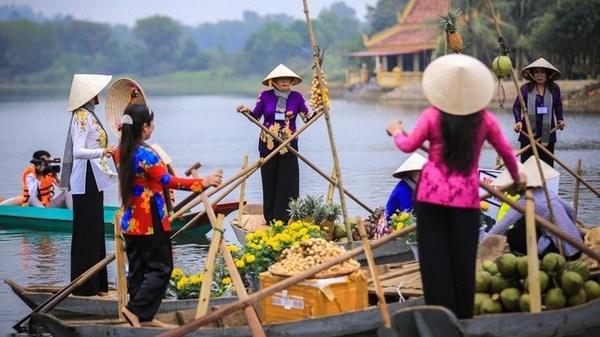


|
A highlight of the "Great National Unity – Vietnam’s Cultural Heritage” Week is the re-enactment of the culture of Cai Rang floating market (Photo: VNA) The annual week aims to honour the cultural heritage of
Vietnam’s ethnic groups and help to enhance the great national unity bloc. It
marks the founding anniversary of the Vietnam Fatherland Front (November 18,
1930) and Vietnam Cultural Heritage Day (November 23).
This year’s event has attracted the participation of nearly
200 people from 13 ethnic groups, namely Tay, Dao, Mong, Muong, Thai, Kho Mu,
Ta Oi, Co Tu, E De, Khmer, Cham, Kinh and Raglai, along with local tourism
associations and travel companies.
A highlight of the week, which lasts until November 23, is
the re-enactment of the culture of the Cai Rang floating market, which is
part of a national intangible cultural heritage. Cai Rang, one of the three
largest floating markets in the Mekong Delta city of Can Tho, specialises in
trading fruit and specialties from the Mekong Delta region.
The re-enactment of Cai Rang market’s culture will include
performances of the art of "Don ca tai tu” music and song, named in UNESCO’s
Representative List of Intangible Cultural Heritage of Humanity.
Various activities will be held as part of the week, such
as ethnic group exchanges, a workshop on developing the Vietnam National
Village for Ethnic Culture and Tourism and the inauguration of phase I of the
Phap An Pagoda in the village.
At the opening ceremony, Chairman of the Vietnam Fatherland
Front Central Committee Tran Thanh Man said that the great national unity
bloc is always the most important and strongest resource for the whole Party,
people and army to overcome every difficulty and challenge in order to
succeed in its reform and national development.
Great unity is also one of the most precious cultural
values of the Vietnamese people, he noted, calling on people from all social
strata to join hands and utilise the strength of the great national unity
bloc.
|
Source: NDO
At the end of May, the Hoa Binh Provincial Ethnic Arts Troupe organized a series of performances for residents in Region 2 and Region 3 communes across the province. Bringing art to ethnic communities in remote, isolated, and especially disadvantaged areas has become a meaningful activity. These are not merely artistic performances but also journeys to disseminate cultural values, enrich spiritual life, and contribute to preserving the cultural identity of ethnic minorities.